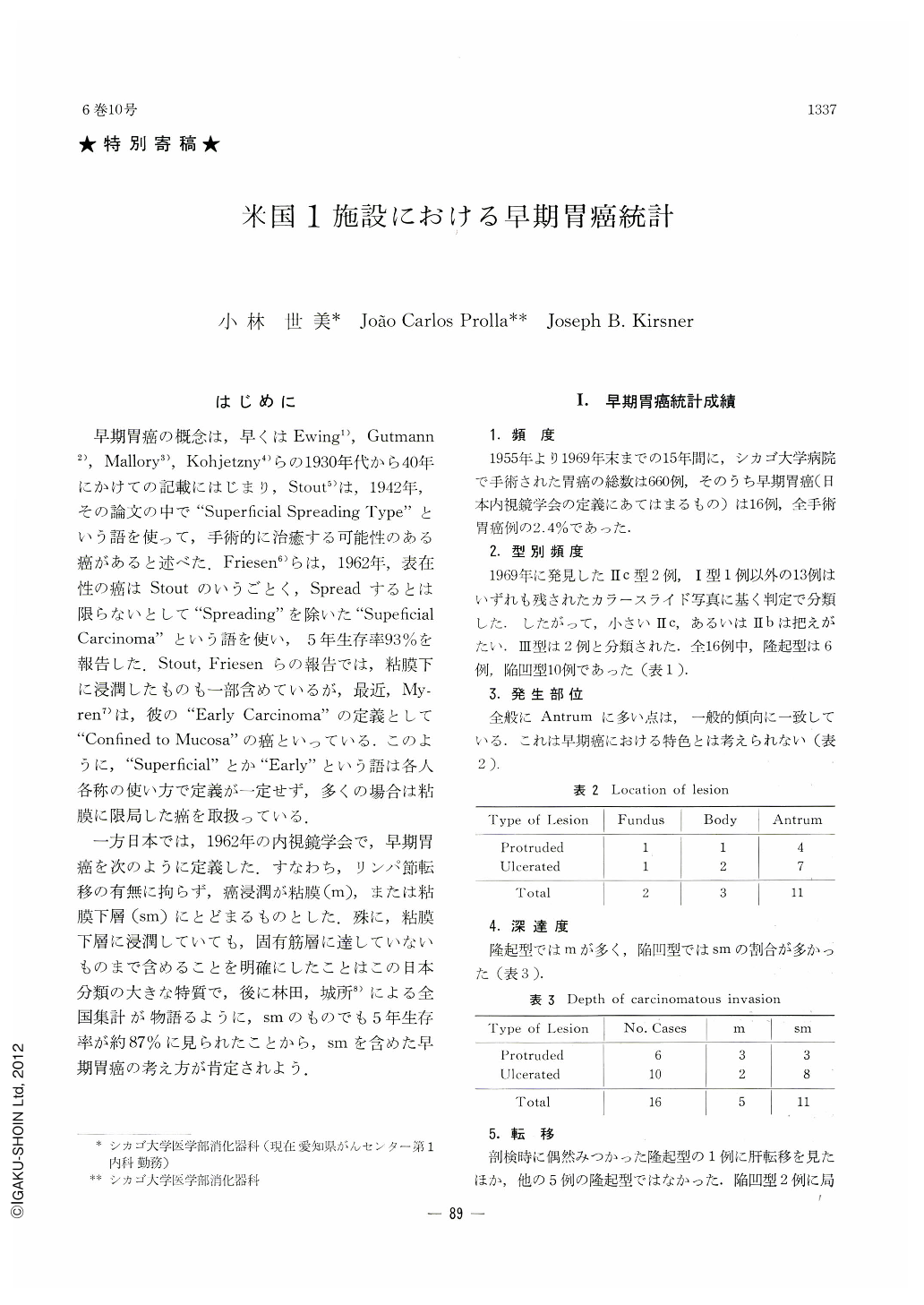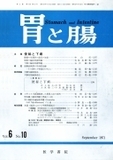Japanese
English
- 有料閲覧
- Abstract 文献概要
- 1ページ目 Look Inside
はじめに
早期胃癌の概念は,早くはEwing1),Gutmann2),Mallory3),Kohjetzny4)らの1930年代から40年にかけての記載にはじまり,Stout5)は,1942年,その論文の中で“Superficial SpreadingType”という語を使って,手術的に治癒する可能性のある癌があると述べた.Friesen6)らは,1962年,表在性の癌はStoutのいうごとく,Spreadするとは限らないとして“Spreading”を除いた“Supeficial Carcinoma”という語を使い,5年生存率93%を報告した.Stout,Friesenらの報告では,粘膜下に浸潤したものも一部含めているが,最近,Myren7)は,彼の“Early Carcinoma”の定義として“Confined to Mucosa”の癌といっている.このように,“Superficial”とか“Early”という語は各人各称の使い方で定義が一定せず,多くの場合は粘膜に限局した癌を取扱っている.
一方日本では,1962年の内視鏡学会で,早期胃癌を次のように定義した.すなわち,リンパ節転移の有無に拘らず,癌浸潤が粘膜(m),または粘膜下層(sm)にとどまるものとした.殊に,粘膜下層に浸潤していても,固有筋層に達していないものまで含めることを明確にしたことはこの日本分類の大きな特質で,後に林田,城所8)による全国集計が物語るように,smのものでも5年生存率が約87%に見られたことから,smを含めた早期胃癌の考え方が肯定されよう.
As the result of a review study of gastric carcinoma operated upon at the University of Chicago during the period from 1955 to 1969, 16 cases of early gastric carcinoma which was defined as confined to the mucosa or/and submucosa by the Japanese Classification proposed by the Japan Endoscopy Society in 1962, were found in a total of 660 cases of gastric carcinoma studied. Of the 16 cases, 6 were of protruded type and 10, of depressed type. They were more common in the antrum, as advanced carcinomas also were.
Invasion of carcinoma confined to the mucosa was predominantly seen in the protruded lesions, and invasion to the submucosa but not reaching the muscularis propria was often seen in the depressed lesions.
Metastasis was noted in three cases; in one (protruded lesion) there was involvement of the liver, and the other two cases (depressed lesions) had regional lymph node involvement, both of them having invasion of carcinoma to the submucosal layer.
Regarding gastric acidity, the presence of free hydrochloric acid was seen in 10 of 13 patients with depressed lesion.
Radiology was very poor in properly demonstrating malignant features of the lesions and only 4 out of 15 cases were correctly diagnosed as malignant on upper GI roentgenograrms. Endoscopy was somewhat better than radiology in establishing a correct diagnosis. A depressed lesion was occasionally mistaken for benign gastric ulcer and a protruded lesion or a depressed one with elevated margins (Type Ⅱa+Ⅱc) was found with considerable ease. Cytology was the most excellent method among the diagnostic tools, having a positive result in 10 (71.4%) of 14 cases examined. Gastroscopic biopsy was performed in only three patients recently seen and all were postitive for adenocarcinoma. Summarizing all diagnostic efforts, 12 (75%) of the 16 cases (90% of the depressed lesions and 50% of the protruded lesions) were correctly diagnosed by at least one of the methods.
Nine (81.8%) of eleven patients who were operated upon over five years ago survived for five years and two were dead: one from postoperative complications within a month following the operation and the other from cardiac disease three years later. No death from recurrent tumor was noted in the early gastric carcinomas. On the other hand, a five-year survival rate was 12.7% among 415 patients operated upon for advanced carcinoma.
It is concluded from the fact that the statistics of gastric carcinoma of the University of Chicago showed an excellent five-year survival rate in the lesions in which carcinomatous invasion was confined to the mucosa or/and the submucosa, and that the Japanese definition of early gastric carcinoma is reasonable from the standpoint of prognosis of gastric carcinoma.

Copyright © 1971, Igaku-Shoin Ltd. All rights reserved.


